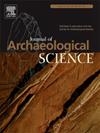通过比较灵长类模型重新思考早期人类的工具制造
IF 2.5
1区 地球科学
Q1 ANTHROPOLOGY
引用次数: 0
摘要
我们对人类认知和语言进化的理解在很大程度上依赖于西方社会人类实验对象对石器时代工具的复制所得出的推论。然而,非人灵长类动物的石头敲击行为可能会补充人类模型,为(前)奥尔多瓦古人类的工具制造行为提供额外的见解,奥尔多瓦古人类在解剖学和认知上比现代人更类似于类人猿。本研究调查了类人猿的减石行为是否在有经验的现代人的范围内。两只倭黑猩猩在制作石器时的行为由两名评分者进行编码,并使用对应分析将其与五名有经验的人类猎手进行比较。我们发现倭黑猩猩制造工具的动作聚集在一起,与现代人类制造砍刀、切割工具和手斧的动作不同。然而,当手斧工具制作动作被排除在外时,动作模式出现了更大的重叠。与倭黑猩猩制造的工具相关的最具区别性的行为包括:在击打之前,用左手握住锤石并在肩膀以上,用手和脚或在地面上支撑核心,以割线角度击打,以及撞击位置远远超出核心边缘。此外,倭黑猩猩的工具与负面打击结果有关(例如,未能产生薄片的打击)。这些结果强调了石器时代的工具是如何制造的可能性是均等的,这对我们仅仅依靠人类受试者来推断人类祖先的技术、认知和语言行为的进化提出了质疑。本文章由计算机程序翻译,如有差异,请以英文原文为准。
Rethinking early hominin toolmaking through comparative primate models
Our understanding of human cognitive and linguistic evolution is largely dependent on inferences drawn from the experimental replication of Stone Age tools by human subjects in Western society. However, the stone-knapping behaviors of nonhuman primates may complement human models by offering additional insights into the toolmaking actions of (pre)Oldowan hominins, who in many respects were more anatomically and cognitively similar to apes than to modern humans. This study investigated whether the stone reduction behaviors of apes fall within the range of experienced modern humans. The actions of two bonobos while engaged in stone toolmaking were coded by two raters and compared to five experienced human knappers using a correspondence analysis. We found that actions associated with bonobo-made tools cluster together and are distinct from those used by modern humans to make choppers, chopping-tools, and handaxes. However, when handaxe toolmaking actions are excluded, greater overlap in action patterns emerges. The most discriminating behaviors associated with the bonobo-made tools include holding the hammerstone in their left hand and above the shoulder before striking, supporting the core on both the hand and foot or on the ground, a secant angle of percussion, and an impact location deep beyond the edge of the core. Additionally, the bonobos’ tools are associated with negative percussion results (e.g., a strike that fails to produce a flake). These results highlight the probability for equifinality in how Stone Age tools were made, calling into question our reliance on human subjects alone for inferring the evolution of technological, cognitive, and linguistic behaviors of our hominin ancestors.
求助全文
通过发布文献求助,成功后即可免费获取论文全文。
去求助
来源期刊

Journal of Archaeological Science
地学-地球科学综合
CiteScore
6.10
自引率
7.10%
发文量
112
审稿时长
49 days
期刊介绍:
The Journal of Archaeological Science is aimed at archaeologists and scientists with particular interests in advancing the development and application of scientific techniques and methodologies to all areas of archaeology. This established monthly journal publishes focus articles, original research papers and major review articles, of wide archaeological significance. The journal provides an international forum for archaeologists and scientists from widely different scientific backgrounds who share a common interest in developing and applying scientific methods to inform major debates through improving the quality and reliability of scientific information derived from archaeological research.
 求助内容:
求助内容: 应助结果提醒方式:
应助结果提醒方式:


